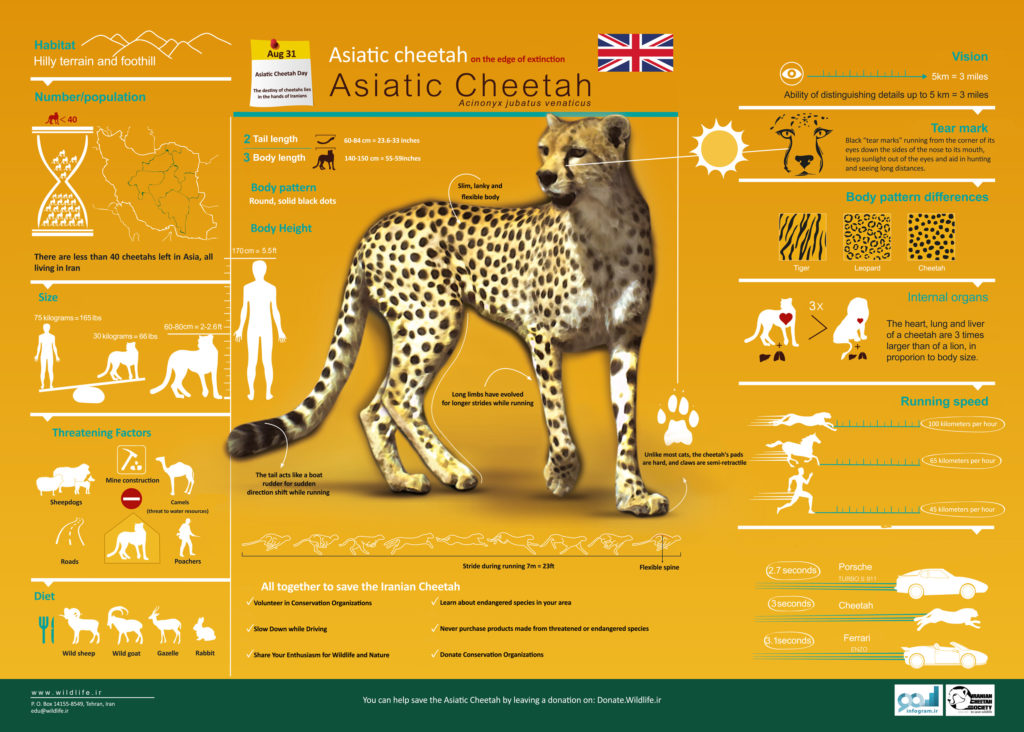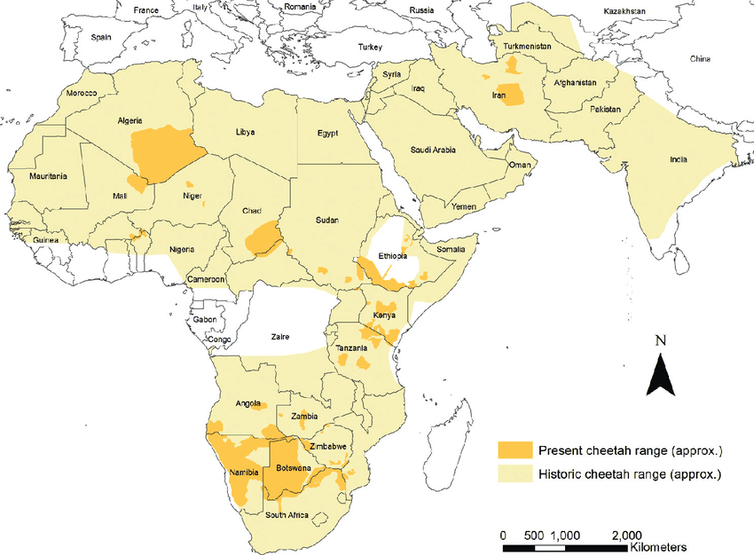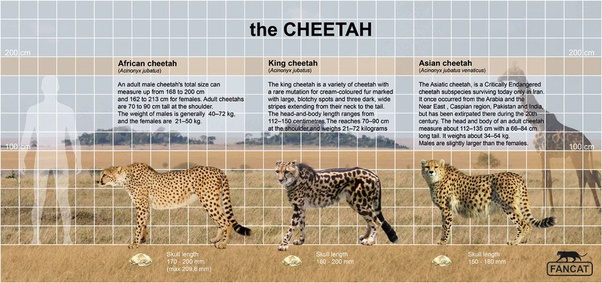Just a century earlier, the Asiatic cheetah were a common sight and roamed carelessly, all the way from Israel in Arabian Peninsula to Iran, Afghanistan and India till the very south of this Subcontinent.
But the beauty of this majestic animal proved deadly and threatening to its very existence.
Like we Humans are, we were so thoughtful of our need and greed that we barely looked that these oversized cats were wiped off their own lands. And hence India declared the Indian Cheetah to be extinct in 1952.
Cheetah, therefore, became the only large carnivore to have extirpated after India became independent.
Few reasons to have brought this doom upon them included the habitat loss(grasslands), increased human-wildlife conflict, loss of prey, illegal trafficking, increased in-breeding and indiscriminate hunting by Royals during Colonial times.
With growing concerns, in early 2000s, Indian scientists from the Centre for Cellular and Molecular Biology (CCMB), Hyderabad proposed to clone the beast but with complexities involved in acquiring the cells to replicate, the plan was put to suspension.
However, in 2020, Indian Supreme Court allowed Government of India to introduce the African cheetah to a suitable habitat in India.
Green signal by concerned Authorities:
National Tiger Conservation Authority (NTCA) as well as International Union for Conservation of Nature (IUCN) have given a ‘no objection’ for the translocation of Cheetah from upon reaching a fair set of understanding with South Africa and Namibia.
According to an eminent Conservationist MK Ranjitsinh, the main idea behind re-introduction is to bring back the only big mammal species that we have lost in peninsular India in historical times.
The initial proposal in 1970s was to trigger re-introduction of Cheetahs in Indian lands using Asiatic Cheetah specie by swap method with Iran.
He explains: “I was negotiating with Iran at the time for 250 Asiatic cheetahs. Their Asiatic lion had disappeared while we had 260 lions.
There were several factors. The regime in Iran changed, Ms Gandhi in India fell from power at that time. And by the time she came back in the 1980s the number of cheetahs had fallen tremendously.”
Asiatic Cheetah are now barely 50 in numbers and hence, stated “critically endangered” by IUCN.
According to a senior scientist at WWI: “For any successful introduction programme, at least 30-40 individuals of a species must be supplied to the location where they are being introduced. There are not these many Asiatic cheetahs alive and therefore the plan fell through.
But the closest to Asiatic cheetah is African cheetah. They are the same species. All cheetahs including the Asiatic cheetah originated from Southern Africa.”
However, Asiatic cheetahs are slightly smaller and slender than the African cheetahs.
What is their Natural Habitat?
They require vast tracts of serene grasslands, open woodlands and scrub-thorn forests with abundant prey base.
According to an Amicus Curiae(friend of the Court) report submitted in the apex court in 2017, “the average home range of an adult cheetah varies from 100 sq kms to 1,500 sq kms”.
Nauradehi in Madhya Pradesh and Gandhi Sagar-Chittorgarh-Bhainsrorgarh sanctuaries in Rajasthan, has been found to a suitable area for guest cheetahs as its forests are not very dense to restrict the fast movement of the spotted cat. Besides, the prey base for cheetahs is also in abundance at the sanctuary.
Kuno-Palpur wildlife sanctuary, spread over an area of 748 sq kms in the central Indian state of Madhya Pradesh, Gujarat and Rajasthan, has been almost ready for the big cat. It has a favorable prey base for the feline too along with reduced Human interference, as per site assessment done by experts in 2020.
It is one of the six locations surveyed to provide immediate den to the first batch of beasts.
How may Cheetah Reintroduction may help the Ecosystem?
According a recent study, while only 3% Ecosystems remain intact, specie-reintroduction may help revive an ecosystem. For instance, the Project Tiger has helped revive the fading Nature around.
“As a flagship species, the conservation of the cheetah will revive grasslands and its biomes and habitat, much like Project Tiger has done for forests and all the species that have seen their numbers go up.
While there is a lot of emphasis on the preservation of forests, grasslands are a hugely neglected habitat in the country – we have a forest policy but not a grasslands policy. And our most threatened animals and birds are grassland-specific species.”
Challenges Ahead on Road to Glory:
Reports have questioned India’s preparedness for the stating that the areas proposed for the species are “not preferred habitat”.
The allocated sanctuary size in India is not even comparable to that of Africa. According to aforesaid report: “India has a population density of 394 persons per sq km and does not have any national park or a sanctuary of size comparable with the African parks which could accommodate a dozen cheetahs”.
According to certain Wildlife experts, while the habitat selected now is suited to cheetahs, some fear that it may ultimately evolve into dry, scrubby forest that is more suited to tigers in the long run.
As tigers are also pouring in to Kuno-Palpur as they may tend to escape territorial over-crowding in nearby connected through a corridor from Ranthambore NP.
There has been no alternative solution to this conundrum. And we need one from the fact that no available science currently suggests that cheetahs, lions, tigers and leopards could coexist in the same habitat without unhealthy competition.
Alongside, wildlife trafficking and poaching are constant threats. Even the protected Tigers are not safe in this country.
We hope that with enough pomp and glory these creatures may be welcomed but in order for them to find peace within the land, serious holes need to be filled in and solutions be provided.
Though we may want to bring in the lost glory of our Nation with the lost specie but we need to keep in mind that it’s a life we are playing with. A life that may be lost forever in dark future.



